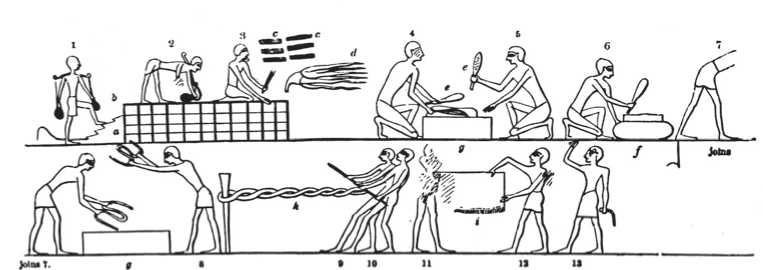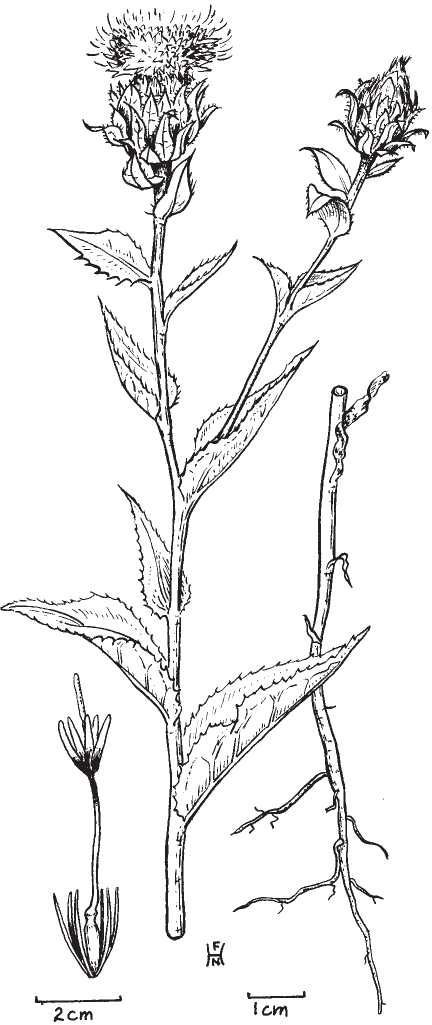This is a cultivated plant that tolerates sandy places. It is now thought to have originated in the Near East where relatives C. persicus and C. palaestinus occur. Whole seeds were found in Tutankhamun’s tomb - fresh seeds yield an edible oil which was also used medicinally.
Safflower is an annual herb growing up to about 1 m (3 ft) high with prickly leaves and a thistle-like head of yellowish-orange florets. Remarkably, these florets yield two colours - yellow and red - but the yellow colour can be washed out of cloth. The red dye, however, is permanent, unless it comes into contact with alkali. Mummy wrappings were often dyed with this plant.

Ancient Egyptians making rope from flax. From J G Wilkinson Manners and Customs of the Ancient Egyptians, London, 1878.

A plant of safflower Carthamus tinctorius.
Cyperus papyrus Papyrus sedge Family: Cyperaceae
This is a marsh-loving plant that grows in enormous stands in shallow water, where its thick horizontal stems (rhizomes) root in the mud. The leaves are reduced to papery scales at the base of the triangular stalk that may attain 5 m (15 ft) or more in height, topped by a huge mop-like flower head. In winter this head is composed of thread-like green bracts, but as the warmer weather comes the small brown flowers appear.
During pharaonic times the Nile Delta supported extensive papyrus swamps, which also occurred with reeds in the Bitter Lakes region - the Sea of Reeds (the Red Sea of Exodus 13:18). These swamps would have supplied papyrus stalks for the manufacture of the writing material. The swamps have gone, owing to pressure of population and land drainage, as well as the extraction of fresh water from the Nile for irrigated agriculture.
Desmostachya bipinnata Haifa grass Family: Gramineae
This is a perennial grass with rigid leaves and a narrow inflorescence up to 40 cm (16 in) high. It grows in waste ground and beside canals in Egypt.
Because it is readily available and the leaves are tough, halfa grass was used for items such as mats, ropes and bags. A bundle was found in Tutankhamun’s tomb and was at first thought to have been used for writing, but this was incorrect as rushes were used for pens and the halfa grass was evidently misplaced.
Imperata cylindrica Imperata halfa grass Family: Gramineae
There are at least two grasses in Egypt known as halfa: Desmostachya bipinnata (above) and this one, which I am calling imperata halfa grass. They are both common and both are used for the same purposes - ropes and simple ties, baskets, matting and suchlike. Only Desmostachya has been identified from Tutankhamun’s tomb, but Imperata may have occurred there and is occasionally found in tombs.
Imperata is commonly found in a wide variety of habitats, where water is not far from the surface. The rhizome is hard and scaly, spreading very easily and
Rooting from the smallest piece, hence the difficulty farmers encounter in trying to clear it from cultivated land. On the other hand, it binds sandy banks effectively. Its tough linear leaves are used for fibrous objects. At almost any time of year, especially in May, the white, cylindrical inflorescence may be seen. It stands 30 cm (1 ft) or more high.




 World History
World History









